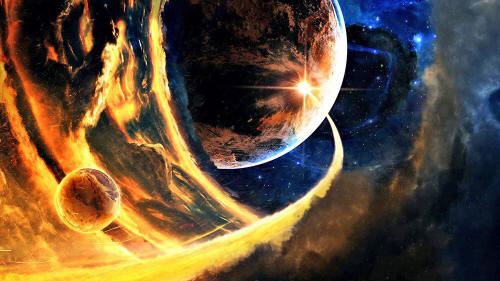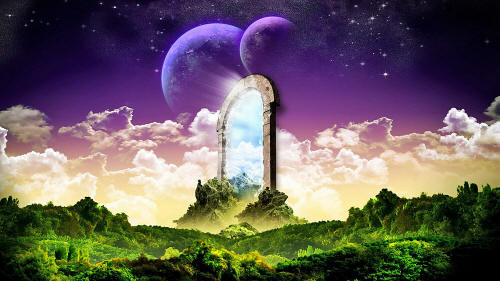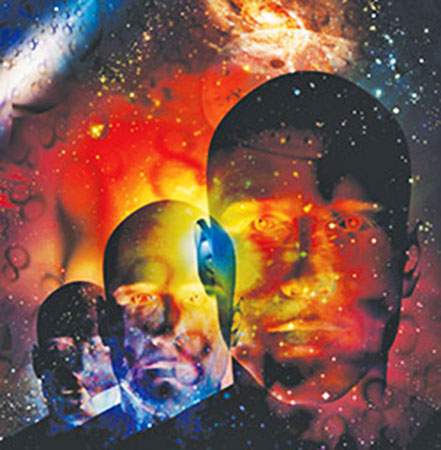|
|
|
...stretched and challenged our imaginations with images and tales of men and women who invented amazing machines and devices that could take them back in time, or forward into the future.
Because of the restrictions of light
speed, and the paradoxes of going back to the past without damaging
the future timeline, and a host of other obstacles and challenges,
we, in fact, have remained stuck in the present.
But perhaps just because we have yet to achieve time travel in our universe, in our particular point along the cosmic arrow of time, doesn't mean it isn't achievable… and maybe the key is the universe itself.
Are we limiting ourselves to our
understanding only of the laws and possibilities of our universe,
and leaving out of the equation other realities, other universes,
with other laws and forces, paradoxes and limitation, possibilities
and potentialities, far beyond our own?
Their machine, a tiny little teleporter barely visible to the naked eye, involves making a tiny metal paddle cool to its ground state, the lowest energy state permissible by the laws of quantum mechanics, and then raising its energy slowly by a single quantum to produce a purely quantum state of motion.
They even were able to put the device in
both states at once, so it vibrated both slowly and quickly at the
same time, in another sort of
Schrodinger's Cat state of
superposition. They posited that we can only see one of these
potential states at once, and upon the act of observation, the state
then splits into additional universes.
Tegmark, asked about the science behind the science fiction, remarked that a wormhole was one possible way of getting something quickly across space-time. However, after admitting that wormholes do appear to be theoretically possible, Tegmark commented that the actual trip would be rather grueling because of the instability of the wormhole.
Many scientists look to the possible existence of other levels of reality, or other universes, as a way to make time travel work outside of the restrictions of light speed and paradoxes.
Imagine another universe alongside our own where the laws of physics are so completely different, that what is impossible here is mundane and trivial there. Multiple worlds, even, where each is different from the other, or perhaps an infinite number of universes where many would be exactly like our own.
Hey, you might even exist in some of
them just the way you are right now. In others, you might be rich,
famous, handsome or even a cockroach! In fact, perhaps you might
even be invisible in one of them!
When talk turns to the multiverse and other similar concepts, it's easy to start dreaming of science fiction worlds with every possible kind of life and all sorts of amazing machines and devices… and time travelers passing effortlessly back and forth between the past, present and future as if it were nothing more than a visit to a few Saturday morning garage sales.
Parallel universes can exist individually, or grouped together as the "multiverse," and offer the possibility of a totally different reality in which someone, or something, can exist, or hop back and forth between.
The laws of nature may be different in
one parallel universe as they are in another, and in respect to time
travel, would provide multiple versions of the future in which
someone could exist, or not exist at all. Light speed limitations
may not exist in a parallel universe, and the paradoxes that keep us
from travelling back in time would be null and void if we could jump
into a different historical timeline.
...both of which involve some sort
of portal or
wormhole, such as a rabbit hole or
a large piece of furniture, through which a person can enter into
another realm.
Theoretically, parallel universes may be the result of a single random quantum event that branches off into an alternative universe. This is the "Many Worlds Interpretation" or MWI, of quantum mechanics, originally formulated by physicist Hugh Everett in 1957.
It posits that each time a different
choice is made at the quantum scale, a universe arises to
accommodate that choice, thus creating infinite new worlds popping
up all the time.
Physicist David Deutsch wrote in "Quantum mechanics near closed time-like curves" for the 1991 Physical Review, that if time travel to the past were indeed possible, the many worlds scenario would result in a time traveler ending up in a different branch of history than the one he departed from.
Deutsch, of Oxford University, is a
highly respected proponent of quantum theory, and suggests quantum
theory does not forbid time travel, but rather sidesteps it,
referring to the traveler's ability to go into another universe, a
parallel universe, and avoid the paradox limitations.
The number of these shadow universes could be enormous, and Deutsch points to photon experiments that suggest possibly a trillion of them or more.
He also suggests that future-directed time travel will essentially only require efficient rockets, and is on the,
When it comes to past travel, the multiverse might save a time traveler from the pesky Grandfather paradox.
He uses an example of a writer who wants to go back in time with a copy of Shakespeare's Complete Works and help the bard complete Hamlet. It can happen, but in the multiverse view,
Another off shoot of the MWI is the
Many-Minds Interpretation, which extends the MWI by positing that
the branching off of worlds occurs in the mind of the individual
observer, introduced in 1995 by theoretical physicist H. Dieter
Zeh, Professor Emeritus of the University of Heidelberg and the
discoverer of decoherence.
The mind may select one identity as its
own non-random "reality," yet the universe as a whole remains
unaffected, which presents additional problems when dealing with
different observers ending up with the same measured realities. The
actual process by which the mind of the observer would select the
single, measured state is not explained by the MMI.
Imagine being able to jump into a timeline where you do get your dream of marrying your high school sweetheart, but, finding out she's an evil tramp as soon as you say "I do," you could jump back into your original historical timeline, where you didn't marry her and instead ended up three years later marrying her sister, your true soul mate, and lived happily ever after.
The 'many worlds' approach (MWI) could solve all the paradoxes in two ways.
First, if we imagine the timeline of our universe as a line drawn on a board, then we can draw another line to represent the universe that branches off from the first. When you go back into the river of time, the river forks into two rivers, and one timeline becomes two timelines, and so on, and so on.
Say you planned to kill your own father. You go back in time and you do the dirty deed.
If the river of time does indeed have many forks, this would not be a problem.
This idea would also solve another thorn in the side of physicists when discussing time travel:
Kaku points out that the main problems involving time travel and wormholes specifically centre on the issues of the physics of the event horizon, as in the stability of the wormhole, the deadly radiation and the wormhole closing once it was entered.
Solve those issues and time travel might
be a piece of cake!
All physicists agree that once they come up with a Theory of Everything that unites the four universal forces of,
...and formulate a complete theory of gravity and space-time, then time travel might be as close as finding a wormhole big enough, stable enough and open enough to get a time machine through.
Not to mention the sheer amount of
energy necessary to do this, which might require harnessing the
power and energy of a neutron star, or finding that elusive exotic
matter scientists are looking for, or a good source of negative
energy, and we are far from doing any of these things.
An interesting problem was brought up by physicist and cosmologist Paul Davies, author of About Time: Einstein's Unfinished Revolution and other books.
In an interview with Discovery.com called "Is Time Travel Possible?" he discussed wormholes as time machines and potential time travel tourists from the future, but with the caveat that,
So, it's all about timing, then… pun intended.
If we can get from here to there, that
is.
These universes may or may not be like ours. In fact, they may or may not even have the same laws of physics or distribution of matter, or even number of spatial and temporal dimensions.
Some will undoubtedly be "dead" and others will have life forms that we cannot recognize or even imagine.
Others still may have duplicates of us
living their own separate lives and timelines. Maybe, Big Bangs are
going on constantly, 24/7/365 all the while creating new universes.
The multiverse has been equated with everything from,
Cosmologist Max Tegmark took the multiverse theory to the next level by creating a classification level for potential other worlds:
Each level of multiverse has its own characteristics that separate it from the other levels, and for our purposes, the focus for time travel would be on those we humans could exist in, and possible travel between.
One of the ways Tegmark differentiated the levels was by stating that in Level One our doppelgängers could live somewhere else in three-dimensional space, but in Level Three they would live on another quantum branch in an infinite-dimensional Hilbert space.
Yet, as the Many Worlds Interpretation states, likely not be able to interact once the split into another branch occurs.
Those found in Level Two might be like
"bubble universes" that have different physical laws and constants,
and each new bubble is created by splits that occur when spontaneous
symmetry breaks occur in Level Three.
He admits that nature may have tricked us into thinking our vantage point was the extent of reality, a fixed view of the world around us.
Many scientists refer to the multiverse as more of a "pocket universe" concept, indicating different regions in space-time that are unobservable, but still a part of our one Universe.
Inflationary cosmology does state these
pocket universes can be self-contained, with different laws of
physics, different particles and forces and possibly even different
dimensions.
Michio Kaku states in Physics of the Impossible that,
Gravity, however, can freely float into the spaces between universes.
Kaku also points to one theory where
dark matter, which is an invisible
form of matter surrounding our galaxy, might actually be "normal"
matter in another universe.
So even though the multiverse theory
takes care of some of the paradoxes by offering up alternate
timelines and histories in which one can both go back to the past
and kill their grandfather (while not killing him at the same time),
it appears as though there is still no realistic way of actually
doing that.
His response was that we must first work out the physics of these other universes, in order to determine when and whether it makes sense to,
He did admit it is possible the stuff we are made of, the matter and forces that make us and hold us together, may not allow us to ever leave our four-dimensional universe and go to another.
Imagine doing so and well, coming
undone!
That knowledge and technology may exist,
though… out there… somewhere in time.
|




